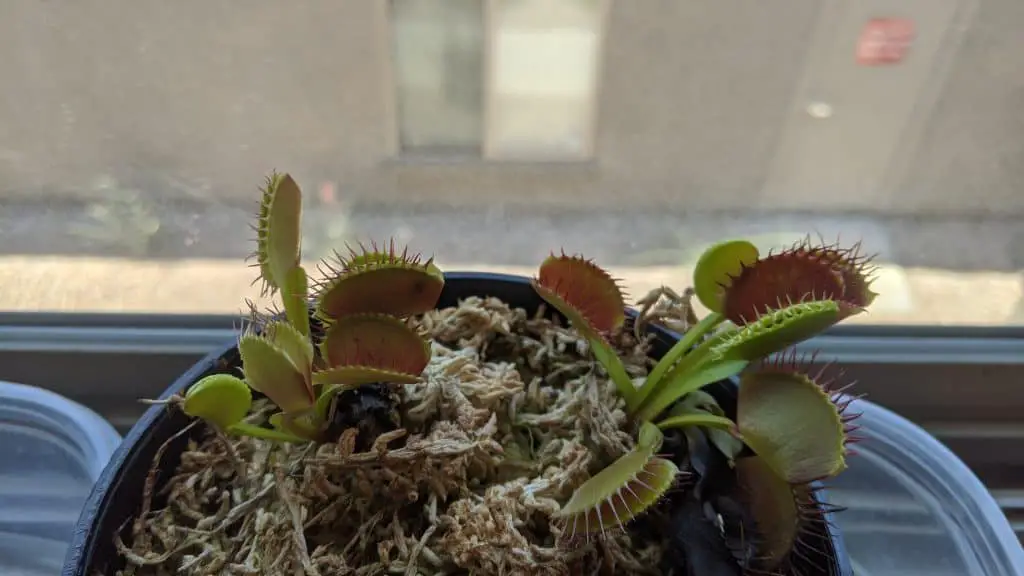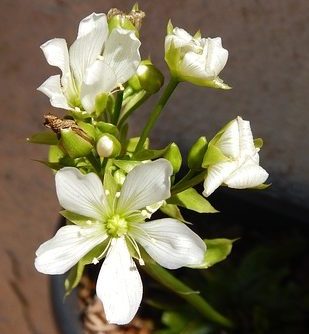The first time I saw a live Venus flytrap was in a hardware store. They were selling them in enclosed containers, like small terrariums. I didn’t really know much about them, but they were fascinating. Eventually, I decided to buy some Venus flytraps to grow at home. Luckily, the plants I bought came with some basic care instructions. Over the years, I started growing more Venus flytraps and perfectioned my plant setup. Depending on your geographical location, you might be able to grow Venus flytraps outdoors, but that is not always the case. Still, you can grow Venus flytraps indoors anywhere in the world! This article will cover an in-depth overview of Venus flytrap indoor care instructions and considerations.
Venus flytraps are native to the wetland of South Carolina and North Carolina in the United States. These plants are well-known for their predatory nature. Venus flytrap can be grown indoors as long as they have access to plenty of light, water, and insects to consume.
General Venus Flytrap Indoor Care
Venus flytrap requires some primary care considerations, regardless of where they are grown.
- Watering: Do not use tap water; only use distilled water, reverse osmosis water, or rainwater. Also, Never let the soil go dry. You must water your plant very often, keeping the ground moist at all times.
- Soil: Use a combination of nutrient-free long-fibered sphagnum moss, sphagnum peat moss, sand, and perlite.
- Lighting: Venus flytraps need more than 4 hours of direct sunlight (you can learn more about the flytrap light requirement here) every day.
- Feeding: Venus flytraps need to consume bugs every few weeks to supplement their diet.
- Stress: Avoid mechanical stress. Do not play with the traps or place your plant next to moving objects.
- Plagues: Keep an eye on your plant appearance—research remedies for the specific disease or plagues you might encounter.
Now, we will expand on some of the care considerations above and cover some specific ones for indoor growing.
Indoor Lighting
Indoors and outdoors, Venus flytraps require plenty of light. They can live under direct or indirect sunlight, but they need to be exposed to proper lighting for more than 4 hours a day to be healthy.
Sometimes it is difficult to find a sunny spot indoors. Some people live in studio apartments with barely any windows. Yet, there is an easy solution: artificial lighting.
“Can you still grow carnivorous plants? Yes. In fact, even if you live in a dark basement or a densely shaded house in a redwood forest, carnivorous plants can thrive even in the darkest corners. The solution is to grow them under artificial lighting” (D’Amato’Amato, 2013)
Do not be afraid to use artificial lights. Many growers use them as the primary or only light source for their carnivorous plants. There is a wide variety of suitable plant light options in the market. High Output fluorescent lights are best for Venus flytraps. Make sure you buy one with an automatic timer and set anywhere between 4 to 12 hours.

Indoor vs. Outdoor Feeding
When Venus flytraps grow outdoors, they are more self-sufficient. For example, they can catch their own food.
Beyond photosynthesis, Venus flytraps capture bugs to supplement their diet. Venus flytraps use their traps to capture prey. Then, they digest the victim to extract critical nutrients.
Outdoors Venus flytraps capture their prey as they do in the wild. Indoor Venus flytraps need human help to get those extra nutrients.
When you grow these plants indoors, they won’t commonly have access to prey. Then, you will have to do the feeding. Follow these considerations to feed your plant properly:
- Frequency: Remember, the bugs are just a diet supplement. Do not overfeed. Give your plant one insect every 2 to 6 weeks.
- Quantity: Do not feed more than one trap at a time.
- Prey size: Only use bugs that can fit entirely inside a trap.
- Diet: Only feed your plant with insects or arachnids. Do not experiment with human food.
Sometimes I notice that one of my Venus flytraps growing indoors has caught prey. In that case, I skip a feeding.
Learn more feeding details and prey options with this article: How to Feed a Venus Flytrap?.
Temperature
Indoor temperatures do not tend to get extremely cold, but they can get very hot. When people look for a sunny spot at home to grow their Venus flytraps indoors, windows are usually a great option. But window side placement can sometimes get too hot depending on where you live.
I live in Arizona, and summers can be brutally hot. I have made a mistake before placing one of my plants in a sunny window without any shield. Even though the temperature inside my home is set to room temperature, some of the windows get dangerously hot for plants and can dry them out quickly!
Generally, monitor the overall temperature of the environment. Venus flytraps can withstand heat close to 90F and cold temperatures down to 30F. If you keep your plant within this range, you are all set.
Dormancy Indoors
In the wild, Venus flytraps experience dormancy during winter months. This process is essential to the plant and happens every single year. To achieve dormancy, your plant needs to be exposed to lower temperatures for several weeks.
Temperature Requirements: Venus flytraps require a dormancy temperature between 45 F (8 C) and freezing (32 F / 0 C) [1]. If you live in a geographical location that archives those temperatures, consider placing your plants in a cold garage or basement.
It is possible to achieve natural dormancy indoors, but only in suitable climates. Tropical locations, for example, will never reach such low temperatures. In those scenarios, you can experiment with induced dormancy.
Induced Dormancy: Some areas never experience temperatures below 50 F. Some others do, but only for a week or two. In those locations, it can be almost impossible to reach the dormancy state of Venus flytraps naturally. As a last resort, you can induce dormancy by placing your plants in the fridge. There is a whole process associated with this method of inducing dormancy. Read the article below for the complete detail on the refrigerator dormancy method.
Refrigerator dormancy: Winter is Coming! A Guide to Venus Flytrap Dormancy
SKIP DORMANCY
It is possible to skip dormancy. However, it is not healthy for your plant. Venus flytraps won’t die right away without dormancy, but their lifespan will shorten. In the wild, Venus flytrap can live for 20 years or more. But, plants that do not undergo dormancy die within a few years.
Flowering and Propagation
During spring, once dormancy is finished, Venus flytraps start producing flowers. Regardless of where your plant is grown (outdoors vs. indoors), several flower stalks will start spurring.
When you spot the flower stalks, you will have to make a decision. You have two options.
- Let your plant flower
- Cut off the flower stalks before the plant has flowered
 Option1: Let your plant flower
Option1: Let your plant flower
The flowering process is entirely normal. However, Venus flytraps spend substantial amounts of energy producing those flowers for reproduction.
The flowering process won’t kill your plant, but it will slow down its growth.
If you are confident in your plant setup, then you can let your plants flourish. They will produce several stalks through the season, each with several white flowers.
The flowers in Venus flytraps are pretty, but they are not out of the ordinary. The exciting part about the flowering process is to attempt to produce seeds by pollinating the flowers.
Your indoor Venus flytrap won’t have access to natural pollinators. However, you can act as a pollinator and manually transfer the pollen from the anther to the stigma.
Option 2: Cut off the flower stalks before the plant has flowered
When you cut off the flower stalks, your plant will save a lot of energy. During the upcoming months, your Venus flytrap will grow rapidly into its prime.
If you are a novice Venus flytrap grower, I would suggest skipping the flowering process. Instead, focus on improving your plant’s setup and keeping them healthy.
How and when to cut them?
Cut off the Venus flytrap flower stalks as soon as you spot them. They look different from leaves, as they grow like thick tubular structures. You can cut them off with small gardening scissors.
Terrarium
Terrariums are sealable containers with soil and water, where plants can be grown in a self-sufficient environment. Venus flytraps can develop well inside a terrarium. Terrariums keep the environment humid and within mild temperatures.
Remember that there are several different types of terrariums. For example, a Green-house style terrarium can hold several plants. But each of the plants lives in its independent pot.
Green-house terrariums are an excellent fit for carnivorous plants as you can grow different types within the same terrarium. Also, you can easily extract Venus flytraps and other species when it is time for dormancy.
When opting for a terrarium, remember the dormancy season. During winter, make sure to place your Venus flytrap in a cold environment so that it can experience dormancy.
PRO Tip Summary
- Do not hesitate to use supplemental lighting indoors. Employ high-output fluorescent light for your Venus flytraps. Also, do not forget to buy a plant light with an automatic timer!
- Venus flytraps growing indoors, still need to consume bugs. You can buy crickets, mealworms, or bloodworms at your local pet store and feed your plant. Your Venus flytrap won’t die without feed, but it won’t be able to thrive.
- Some areas at home can get very hot and kill your plant. Monitor window or balcony temperatures, before placing your Venus flytraps there.
- Venus flytrap should experience dormancy every year. First, try to achieve dormancy naturally. As a second option, you can use the refrigerator method.
- As a novice grower, skip the flowering process if possible. Cut off the flower stalks to speed your plant’s growth.
- You can grow Venus flytraps in terrariums. Still, do not forget your Venus flytrap in the terrarium should also experience dormancy.
- Place your Venus flytrap pot on top of a plate or container with water. The water in the dish acts as a reserve.

